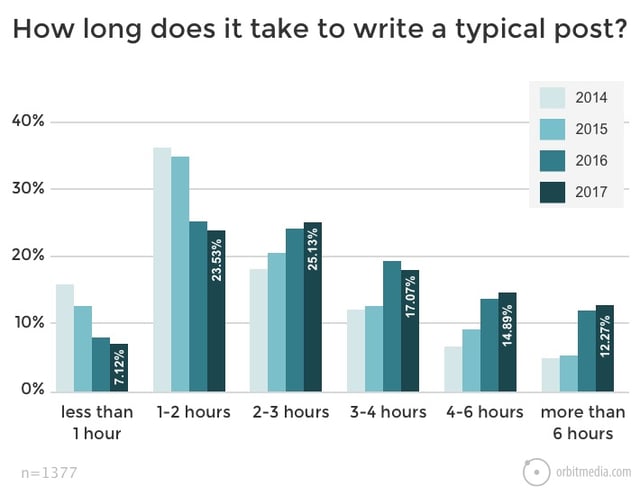 Are you considering blogging for your business and wondering what you can expect? These 79 blogging statistics will help.
Are you considering blogging for your business and wondering what you can expect? These 79 blogging statistics will help.
Especially since business blogging represents the single most effective investment you can make to ensure your business remains relevant and visible to potential customers over time. It's a serious tool with SEO (search engine optimization) implications. It offers serious content repurposing possibilities, not to mention that it can be a magnet for generating leads and having something to contribute to social networks.
As with anything worth doing, though, it takes effort and commitment.
To put into perspective not just what you can expect from blogging, but also what it takes to be successful, here are the latest and most relevant blogging statistics available, including valuable insights from Orbit Media's recently published 4th annual research on blogging, Blogging Statistics and Trends: The 2017 Survey of 1000+ Bloggers.
Basic Business Blogging Statistics
Big picture: Publishing content on blogging platforms is serious business and people read that content. Google indexes blog content so articles show up in search results. For companies wanting to compensate for the growing use of ad blockers, blog content works.
1. According to the blogging platform Wordpress, over 409 million people view more than 22.2 billion blog pages each month.
2. Wordpress users produce about 91.8 million new posts and 48.9 million new comments each month.
3. 36% of the Fortune 500 are using their blogs for thought leadership, product promotion and engagement up from 23% in 2010.
4. 7 million people publish blogs on blogging websites, and another 12 million write blogs via their social networks. (Top Blogging Statistics: 45 Reasons to Blog)
5. 76% of B2B marketers blog, and 73% publish case studies. (Source: Content Marketing Institute)
6. On average, Google gets over 100 billion searches a month. (More than half of Google searches now come from mobile.)
7. 77% of Internet users read blog articles.(52 Reasons Your Company Blog is Worth the Time & Effort)
8. 43% of people admit to skimming blog posts. (HubSpot's Ultimate List of Marketing Statistics)
9. There were 198 million active adblock users around the world as of 2015 (Source: PageFair Adblocking Report Quick Facts)
10. As of 2013, 86% of consumers are banner / ad blind (Adotas)

What Kind of Results Can You Expect from Business Blogging?
Big picture: The benefits of business blogging are real in terms of attracting traffic to websites, generating leads, inbound links, email traffic and a return on investment (ROI).
11. Business blogging helps drive traffic to your website. Companies that blog receive 55% more traffic than companies that don't and they have 434% more indexed pages compared to those that don't.
12. Active company blogs have 97% more inbound links than websites without blogs. (Source HubSpot)
13. Active company blogs generate 67% more leads than websites without blogs. (Source HubSpot)
14. Blogging Businesses Experience 126% Higher Lead Growth Than Non-Blogging Businesses
15. B2B marketers have found blogging to be significantly more time and cost-effective than traditional lead generation methods (Source: Hubspot)
16. Businesses That Blog Generate 2X More Email Traffic compared to those that don't blog.
17. Marketers who prioritize blogging efforts are 13x more likely to see positive ROI (Source: HubSpot)
18. 82% of marketers who blog consistently see positive ROI from inbound efforts (Source: HubSpot)
19. Companies that implement content marketing strategies see 6x higher conversion rates than those who don’t (How to Win Your Battle for Content Marketing Buy-in [50+ Stats])
20. SEO leads have a 14.6% close rate, while outbound leads (such as direct mail or print advertising) have a 1.7% close rate. (24 Eye-Popping SEO Statistics)
Stats About Business Blogging and Trust
Big picture: Blogs enable companies to educate prospective customers, build trust, be thought leaders and generally get closer to their prospects.
21. Blogs are trusted sources of information and advice say 81% of US online consumers. (Source: BlogHer 2012 Research Slide 7)
22. According to 81% of Shoppers Conduct Online Research Before Buying,
"Eighty-one percent of shoppers conduct online research before they make a purchase. Sixty percent begin by using a search engine to find the products they want, and 61 percent will read product reviews before making any purchase. On average, a consumer will visit three stores before making their purchase."
23. Which channels do consumers use when researching products before buying online? represents research published in September 2017. Although the research shows "the importance of a fully integrated multichannel marketing strategy, if you want to success and get one step ahead of your competition, no matter the age group you are targeting," website content is the most valued/used for research: 72% for Millennials, 71% for Gen X and 61% for Boomers.
24. 96% of B2B buyers want content from industry thought leaders. (2016 Content Preferences Survey: B2B Buyers Value Content That Offers Data And Analysis)
26. 61% of US online consumers have made a purchase based on recommendations from a blog. (BlogHer: Women and Social Media 2012)
From How to Build a Credible Blog [Infographic]:
27. 68.52% of respondents say that a blog adds credibility to a website.
28. In terms of which factors add credibility to a blog, 30% say quality content, 17% say good design, 15% say regular publication of content, 13% say good social media presence, and 12% say good authors.
29. 62.96% say multiple authors add credibility to a blog.
30. As far as which types of content add the most credibility to a blog, written articles top the list at 44.44%, ebooks are next at 19.44%, visuals and videos are next at 14.81% each.
31. According to What data tells you about the need for Content Marketing, 70% of consumers prefer getting to know a company via articles rather than ads.
Statistics About Blogging for Business
Big picture: Bloggers are spending more time writing blog articles even though they become more efficient in their writing process over time. The biggest reason for this? Blog articles have gotten longer to stand out. Other observations include:
- Article titles are worth spending time on.
- Typical blog posts include more than one image, lists and possibly video.
- Publishing frequency has decreased to between once a week and once a month. Most critical is publishing regularly.
- Frequency of publishing affects traffic volume.
- It's worth updating older posts
- Definitely promote your blog content via social media.
- SEO matters as does email.
- The biggest growth in how to promote blog posts comes from paid promotion.
- Yes, business blogging generates results.
How long takes to write a blog post?
32. According to Orbit Media's recent study, in 2017 it takes on average 3:20 hours up from 3:16 in 2016.
33. For added perspective, according to How to Write a Blog Post: A Full Breakdown of How We Do it at Buffer, it took the author an average of 2 hours, 58 minutes to write a 1500 to 2000+ word blogpost. The longest post took 3 hours, 33 minutes. The shortest post took 2 hours, 23 minutes.
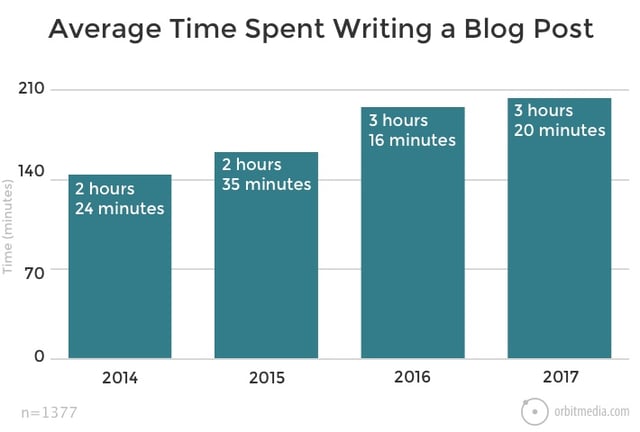
34. According to How Long Should It Take You to Write a Blog Post?, a 500-word post in North America broke down as follows:
"The largest number of marketers (38%) spend 1-2 hours writing a typical blog post. In the same region, 29% of marketers spend 2-3 hours writing a blog post, 29% spend 4+ hours per post, and only 8% spend less than an hour per post."
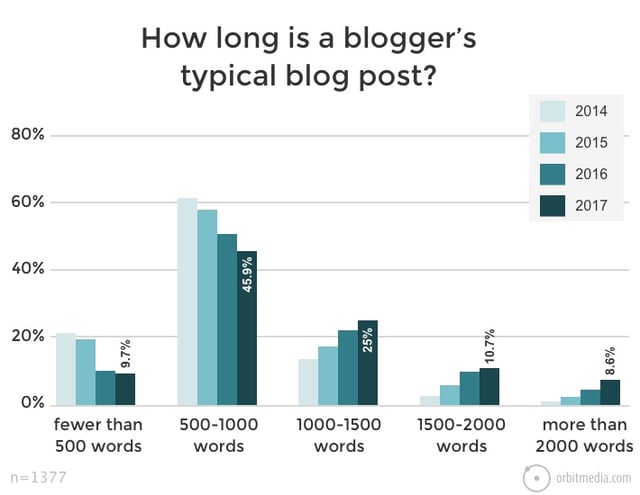
How Long is a Typical Business Blog Post?
35. According to Orbit Media's 2017 research, a typical blog post is 1142 words, up from 1054 in 2016 (and 808 in 2014).
36. The average Google first page result contains 1,890 words, says We Analyzed 1 Million Google Search Results. Here’s What We Learned About SEO.
37. The Character Count Guide for Blog Posts, Videos, Tweets & More explains that,
"That means that this ideal word count can address goals around both readability and SEO. But that's just the actual body of the post. Plus, when we looked at our own blog on organic traffic, we found that the sweet spot was 2,250–2,500 words."
38. As a further incentive for long-form content, Long-Form Content vs. Short-Form Content explains that,
"...long-form content allows you to provide more value. The point of a long-form post isn't to reach a particular word count for the sake of that word count, but instead to provide so much valuable information that it reaches or exceeds a particular word count. Writing long-form allows you to take a reader from beginner to advanced material on a topic within one post.
Providing that kind of value attracts more people to your content, inspires them to share it with others, and positions your brand as an authority. In fact, BuzzSumo found that "the longer the content, the more shares it gets, with 3000-10000 word pieces getting the most average shares (8859 total average shares)."
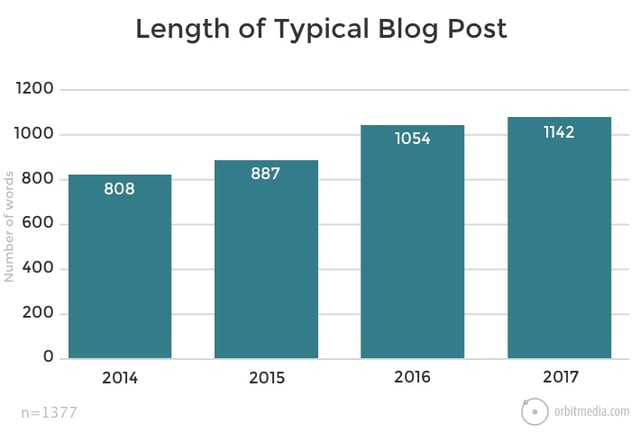
Stats About Blog Article Titles
39. According to How testing 10 headlines revealed a 3-letter word that improved conversion more than major changes, marketers should embrace the following two principles when crafting headlines (in this case, it led to a 10.4% improvement in conversion):
"Principle #1: All marketing messages must be centered primarily on the interests of the customer. Therefore, when it comes to crafting headlines, emphasize what the visitor gets rather than what they must do.
Principle #2: The goal of a headline is similar to the goal of the opening scene of a movie — to arrest the visitor's attention and get them into the first paragraph. Therefore, utilize a “point-first” structure (i.e. place the value at the front of the headline)."

40. Content Marketing Institute discovered that titles with eight words received a 21% higher click-through rate than average.
41. It also found that a colon or hyphen in the title can lead to a 9% improvement.
42. And, that odd-numbered list titles perform 20% better than even ones.
43. HubSpot recommends blog titles with 6-13 words, and no longer than 14.

What's In a Typical Blog Post?
44. According to Orbit Media's 2017 Blogger Statistics, over 30% of typical blog posts now include more than one image and a numbered or bulleted list. Including visuals, video and even audio improves results.
45. Blog articles with images get 94% more views. (6 Powerful Reasons Why you Should include Images in your Marketing – Infographic)
46. Using people in real photos (instead of stock ones) can result in a 35% conversion increase (This Just Tested: Stock Images Or Real People?)
47. 53% of content marketers use interactive content (Source: Ion Interactive/Content Marketing Institute 2016 Report). Also see How an Interactive Content Assessment Can Generate Qualified Leads

How Frequently Should You Publish Blog Articles?
48. According to Orbit Media's 2017 research,
- Publishing frequency for individual bloggers is down. The most common answer is “several per month.” Two years ago it was “2-6 times per week.”
- Daily and monthly are unusual. Most bloggers are somewhere in between.
- Consistency remains steady! Around 85% of bloggers publish regularly.
According to HubSpot's Blogging Frequency Benchmarks,
49. B2B companies that blogged 11 times or more per month got 3X more traffic than those blogging only once or less per month.
50. Companies that publish 16+ blog posts per month get nearly 3.5x more traffic than those that publish 0-4 monthly
51. B2C companies that blogged 11 times or more got more than 4X as many leads than those that publish only 4-5 posts per month.
52. Companies that publish 16+ blog posts per month generated 4.5x more leads than companies publishing 0-4 monthly.
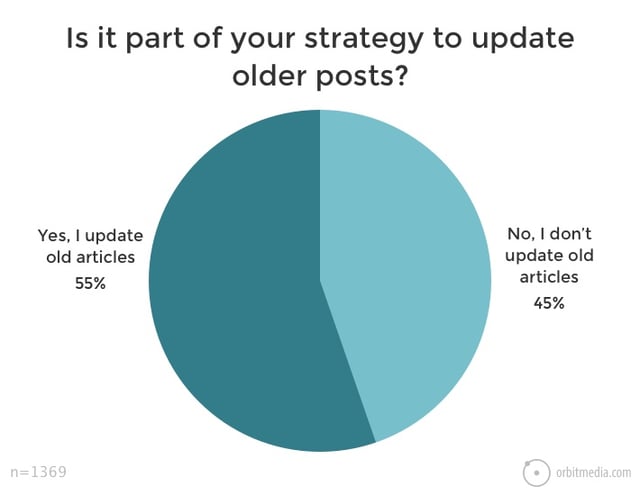
Does Your Blog Content Strategy Include Updating Older Blog Articles?
53. In Orbit Media's research, 55% of bloggers said that they update old articles.
54. 75% of HubSpot’s blog views and 90% of blog leads come from old posts. (Source: It's the End of the Month. Do You Know Where Your Blog Leads Are Coming From?)
According to Compounding Blog Posts: What They Are and Why They Matter,
55. 1 in 10 blog posts are “compounding”, meaning that organic search steadily increases their traffic over time
56. 1 compounding blog post generates as much traffic as 6 regular posts combined
57. Compounding blog posts generate 38% of all blog traffic
>> See The Ultimate Guide to Pillar Content for Your Website
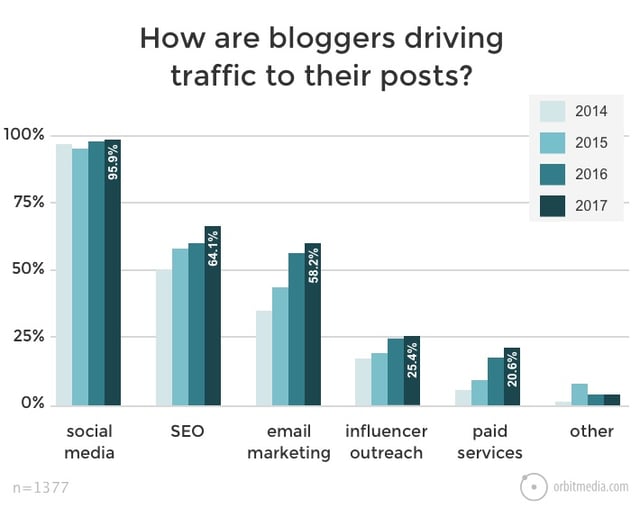
How do Bloggers Promote Their Content?
58. When it comes to promoting blog content, Orbit Media discovered that:
- There is almost a 5x increase in paid content promotion since 2014.
- 1 in 4 bloggers are now collaborating with influencers.
- Almost two-thirds of bloggers pay attention to SEO.
- 42% of bloggers are still not using email marketing.
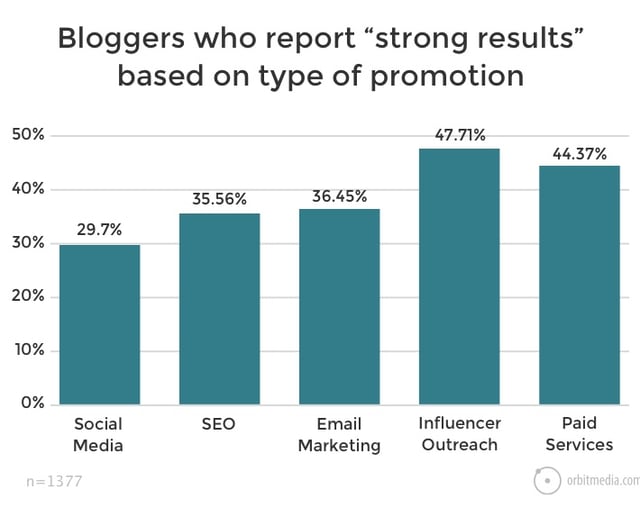
59. To share content, B2B marketers primarily use email (93%) and social media (92%) per 2018 B2B Content Marketing Trends—North America: Content Marketing Institute/MarketingProfs
60. Those B2B marketers use LinkedIn (97%), Twitter (87%), Facebook (86%) and YouTube (60%) to share content on social networks.
61. 8% of marketers plan to add Medium to their marketing efforts in the next 12 months. (HubSpot, 2017)

62. As Orbit Media explains about the 20.6% level of paid blogging promotion,
"The most dramatic trend in this year’s survey: the rise of paid promotion. There are all kinds of ways to promote an article and more bloggers are using more channels. All content promotion tactics are rising in popularity. But bloggers are buying traffic in greater numbers than ever before."
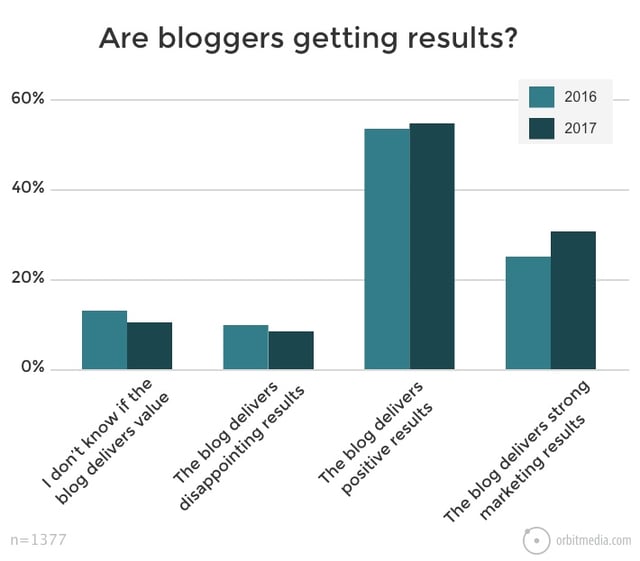
Are Bloggers Getting Results?
63. 82% of marketers who blog see positive ROI for their inbound marketing (10 Inbound Discoveries That Will Disrupt Marketing Forever)
64. 81% of marketers rated their blog as "useful" or "better" for increasing your rankings in search engines and earning you thought leadership. (20 Revealing Stats, Charts, and Graphs Every Marketer Should Know)
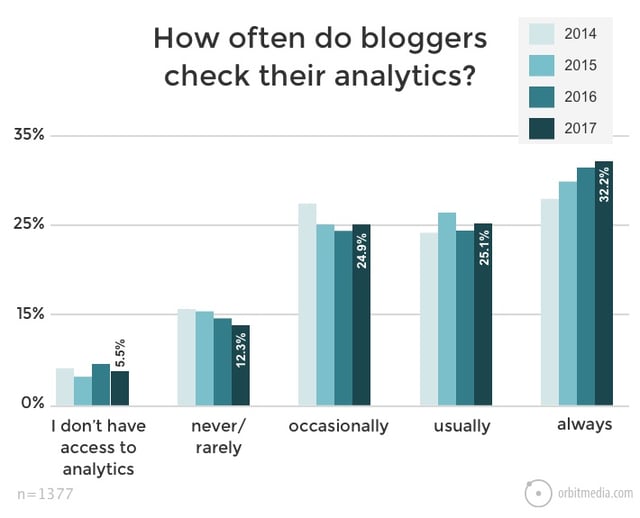
65. Orbit Media's 2017 survey reveals that 42% of bloggers don’t use Analytics or use it only occasionally. (Argh!)
The Blogging Process
Big picture: With blogging maturing and becoming an integral part of content and inbound marketing, it's more important than ever to have a strategy and process to manage content creation, outsourcing and content promotion. Tools help as does ongoing communication.
66. According to Orbit Media's 2017 research about blogging, 1 in 5 bloggers has a formal editing process.
From the 2018 B2B Content Marketing Trends—North America: Content Marketing Institute/MarketingProfs:
67. Nearly half of respondents (56%) outsource at least one content marketing activity; conversely, 44% do not outsource any content marketing activities.
68. The top 5 digital tools used to manage content marketing efforts include analytics tools (87%), email marketing technology (70%), content management system (63%), marketing automation software (55%), and webinar/online presentation platforms (43%).
69. The most effective B2B content marketing professionals meet with their content teams weekly (36%), monthly (16%), biweekly (11%) and daily (8%). (What Effective B2B Content Marketing Looks Like)

Blogging Statistics About the Buyer Journey
Big picture: Ultimately, if you dont' take into account your customer's buyer journey, you'll have a hard time crafting the kind of compelling content that educates and provides value. Marketers consider blog content more effective than advertising because prospects respond. What's not to like?
70. From the 2016 DemandGenReport, 47% of B2B buyers read 3-5 blog posts or content pieces prior to talking with a salesperson
71. 94% of people share blog content because they think it might be useful to other people. (Source: nymarketing.com)
Per 38 Content Marketing Stats That Every Marketer Needs to Know,
72. 72% of marketers think that branded content is more effective than magazine ads.
73. Nearly 49% of marketers are trying to align content marketing with the buyer’s journey
74. 70-80% of users ignore paid ads and only focus on organic results. (24 Eye-Popping SEO Statistics)
75. 78% of consumers believe that companies behind content are interested in building good relationships.
76. 49% of marketers are learning to drive content to align with the buyer’s journey. (35 Content Marketing Stats You Need to Know)
77. 86% of senior-level marketers say that it's absolutely critical or very important to create a cohesive customer journey
Statistics About Blogging Priorities for Marketers
Big picture: Blog content creation is a priority for those marketers who've committed to it as a traffic, lead and customer generation strategy.
78. 53% of marketers say blog content creation is their top inbound marketing priority in 2017 (HubSpot).
79. In 2017, 70% of B2B marketers prioritize delivering high-quality content over quantity (2018 B2B Content Marketing Trends—North America: Content Marketing Institute/MarketingProfs)
How Do These Blogging Statistics Relate to Your Business?
If you've considered a business blog, these 79 statistics should support the direction you're headed in. (If you aren't, then please reconsider. Let me know why you're hesitating.)
Blogging is powerful and it's effective for those committed to creating quality, customer-focused and relevant content. Plus it supports your social media outreach, content offers, pillar content, not to mention developing content clusters.
Let me know of questions.
Thanks for reading.

Amazing Business Blogging Statistics Resources
28 Little-Known Blogging Statistics to Help Shape Your Strategy in 2018
15 Business Blogging Statistics That You Should Know
101 Blogging Statistics for 2017
52 Incredible Blogging Statistics to Inspire You to Blog
2018 B2B Content Marketing Trends—North America: Content Marketing Institute/MarketingProf
Social Media Marketing Industry Report from Social Media Examiner
2017 Blogging Research That Will Make You A Better Blogger
Special thanks to Blogging Statistics and Trends: The 2017 Survey of 1000+ Bloggers (Charts Credit: Orbit Media)



